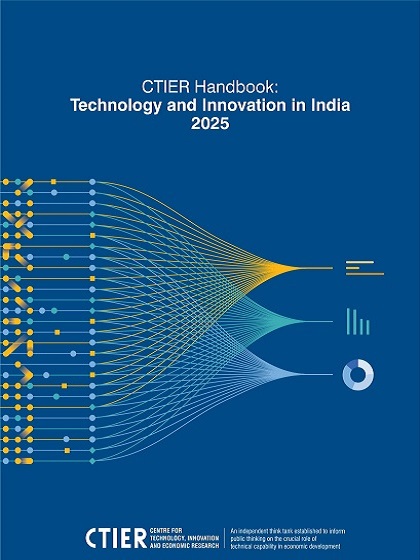India must greatly expand its investment in technology. Indian industry must see R&D as its way of building a future based on proprietary technology. And a much more research-focused higher education system must supply the quality of talent industry needs to do just that. Countries around the world have placed great emphasis on Innovation Policy, drawing on an increasingly rich understanding of what has worked, where and why. This rich understanding needs to be part of all discourse on economic policy. CTIER was established to do just this for India.
Naushad Forbes
Co-Chairman, Forbes Marshall
Chairman, CTIER
Areas of Impact

Featured Work
CTIER Handbook 2025
India is home to some excellent institutions, high calibre talent and successful enterprises. What is missing is the full realisation of our innovation potential. Ten years ago...
CTIER Handbook 2025
India is home to some excellent institutions, high calibre talent and successful enterprises. What is missing is the full realisation of our innovation potential. Ten years ago we established CTIER to bring technical capability and innovation to the forefront of policy discussion and base it on data. We have seen modest but encouraging change since, be it in the policy space or within Indian industry.
This Handbook, now in its fourth edition, is a wealth of information and data on innovation and technology in India. Over the years it has brought together various stakeholders, including industry, government bodies and academia, to derive insights to strengthen India’s R&D and innovation ecosystem. It has helped shape academic thought in the economics of innovation. It has helped design programmatic interventions to build the capabilities needed to transform Indian industry into an innovation powerhouse.
The potential for Indian firms to lead globally in technology is real. Many of our large Indian firms are profitable by international standards; they just invest very little in R&D. For policymakers, the key imperative is to identify who should fund what research (scientific research as well as technological research) and where it is best performed, whether in industry or academia. Unlike the rest of the world, public R&D in India is mostly performed in autonomous government laboratories, which are cut off from our higher education institutes and industry. By doing much more of our public research in our higher education system, we would simultaneously train more advanced talent needed by our industry. And strong inhouse investment within industry is a precondition for taking advantage of public research.
The essays in this edition start with a comparison of data on key innovation parameters between India and the two technology giants, the US and China. In the current environment of intense competition for technology and talent, the essay serves as a reminder of the need for India to capitalise on her strengths in key sectors like pharmaceuticals & biotechnology and automobiles & parts among others, while growing her capabilities in sectors like electronic & electrical equipment. The subsequent essays focus on building a bold ambition for the pharmaceuticals & biotechnology sector and exploring and expanding opportunities in the emerging sectors of semiconductors and electric vehicles.
As before, the CTIER Handbook makes available the most current and useful data on technology and innovation in India. Companies over time tell us about progress we made. International companies tell us how far we have to go. Janak and his young team at CTIER do us all a great service by producing these excellent Handbooks.
Coinciding with our tenth anniversary, this is a special edition for the CTIER team
Deeptech in India: What can the State do?
The innovation capability of a country is a critical deciding factor in the global competition for geopolitical influence and economic growth. In the quest to...
Deeptech in India: What can the State do ?
The innovation capability of a country is a critical deciding factor in the global competition for geopolitical influence and economic growth. In the quest to further India’s status on the world stage, the Government of India has invested policy focus and resources on improving India’s innovation ecosystem. There is a special emphasis on deeptech. In this policy brief we highlight four strategic levers in the policy space to optimise the ongoing transformation of the Indian deeptech ecosystem.
CTIER Innovation Report 2025
The inaugural edition of the CTIER Innovation Report seeks to provide an understanding of where top Indian R&D firms stand relative to their global peers across a number of indicators...
CTIER Innovation Report 2025
The inaugural edition of the CTIER Innovation Report seeks to provide an understanding of where top Indian R&D firms stand relative to their global peers across a number of indicators such as profitability, R&D intensity, exports and patents. We seek to understand how firms are adopting digital technologies across the value chain, including the use of AI. We highlight the opportunities and risks that firms face as a result of blurring industry boundaries. We identify key technologies being worked on for a sustainable future. And we point to the lessons that the hiring practices of global R&D firms offer Indian firms, both in terms of diversity of roles and diversity in talent.
Events
August 2025
CTIER Innovation Report Launched on National Chemistry Day Summit Organised by Godrej Industries Group
The inaugural CTIER Innovation Report, ‘Industry in India: Followers or Leaders?’ was launched at the National Chemistry Day summit organised by the Godrej Industries Group.
The report was launched by Nadir Godrej, Professor MM Sharma, Naushad Forbes, Burjis Godrej, Aniruddha Pandit, Vishal Sharma and Kamlesh Fondekar.
April 2025
Principal Scientific Adviser Unveils Landmark Report on 'Evaluation of Innovation Excellence Indicators of Public Funded R&D Organizations’ (Round 2)
The Office of the Principal Scientific Adviser (PSA) to the Government of India today launched the (Round 2) study report on “Evaluation of Innovation Excellence Indicators of Public Funded R&D Organizations”, aimed at benchmarking and enhancing innovation performance across India’s publicly funded research ecosystem.






